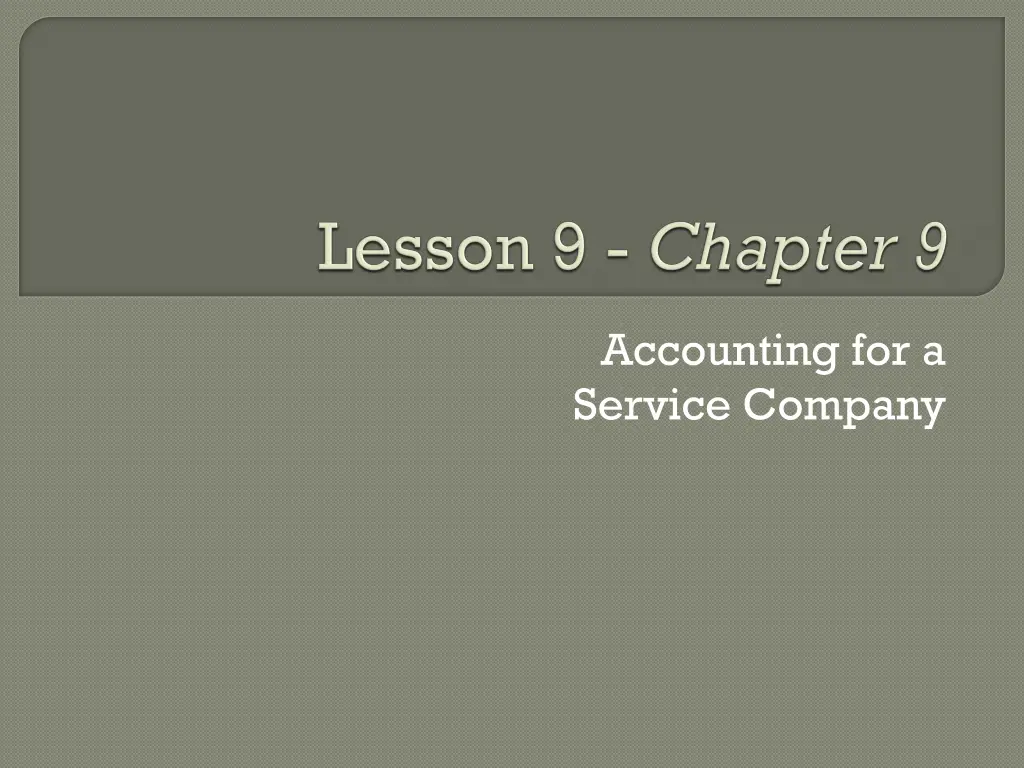
Mastering Accounting for Service Companies: Transactions, Adjustments, and Financial Records
Dive into the world of accounting for service companies with detailed guidance on recording transactions, preparing trial balances, making adjustments, and generating financial statements. Learn about owner investments, purchases, sales, and more essential aspects of accounting for service-based businesses. Utilize tools like journal entries, checks, and invoices to streamline your accounting processes efficiently.
Download Presentation

Please find below an Image/Link to download the presentation.
The content on the website is provided AS IS for your information and personal use only. It may not be sold, licensed, or shared on other websites without obtaining consent from the author. If you encounter any issues during the download, it is possible that the publisher has removed the file from their server.
You are allowed to download the files provided on this website for personal or commercial use, subject to the condition that they are used lawfully. All files are the property of their respective owners.
The content on the website is provided AS IS for your information and personal use only. It may not be sold, licensed, or shared on other websites without obtaining consent from the author.
E N D
Presentation Transcript
Accounting for a Service Company
Record Transactions Prepare a Trial Balance Make Adjusting Entries Prepare an Adjusted Trial Balance Financial Statements & Other Financial Records Income Statement Balance Sheet Statement of Cash Flows Journal Ledger Closing
Owner Investments Purchases Make Payments Sales Receive Payments
Use Record Deposits tool Journal Entry Your Name Checking(Cash) Opening Balance Equity (Capital Account)
Use Write Checks tool Journal Entry Supplies Cash
Purchases on Account - Credit Purchases Use Enter Bills tool to record purchase Use Pay Bills tool to record payment Journal Entry - Purchase Supplies Accounts Payable Journal Entry - Payment Accounts Payable Cash
Use the Record Deposits tool Journal Entry Cash (Your Name Checking) Sales
Use the Invoices tool to record sale Use the Receive Payments tool to record customer payments Use the Record Deposits tool to record deposits Journal Entries Accounts Receivable Sales Cash Accounts Receivable
Used with frequently recurring transactions Transactions have some static (non-changing) data Saves time entering data Record with Edit>Memorize Bill or Ctrl + M Recall with Lists>Memorized Transactions List or Ctrl + T, then double-click the transaction to use
Recorded at the end of the accounting period Brings certain account balances up to date prior to preparing the financial statements Record in QuickBooks using Company>Make General Journal Entries
The Trial Balance indicates a balance of $800 in the Supplies account. A physical count of supplies shows that the company has $250 of supplies on hand. Prepare the adjusting entry to update the appropriate accounts. The company purchased an automobile for $20,000 to be used in the business. The automobile is expected to have a useful life of 5 years and a salvage value of $5,000. Prepare the adjusting entry to update the appropriate accounts. The company has a $12,000 note payable. Interest is to be paid when the note matures, but accrues annually at a rate of 6%. Prepare the adjusting entry to update the appropriate accounts. 1. 2. 3.
Prepare as of the last day in the fiscal period Income Statement Shows the results of operations over a period of time (revenue expenses) Balance Sheet Shows a company s financial position as of a particular point in time (assets = liabilities + equity) Statement of Cash Flows shows how and why the Cash account has changed over a period of time
Close accounts in QuickBooks by setting the Closing Date Company>Set Closing Date Close temporary Accounts Revenue Expenses Income Summary Drawing/Dividends






















